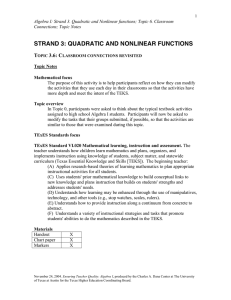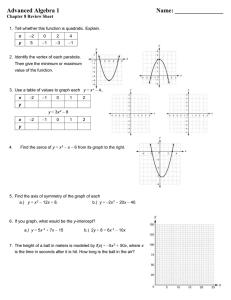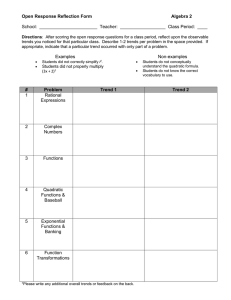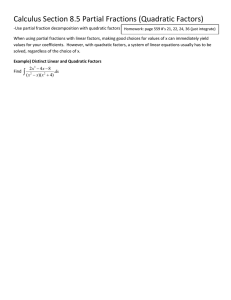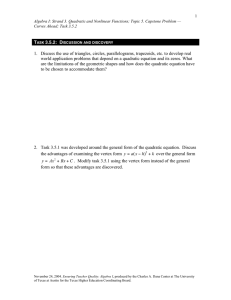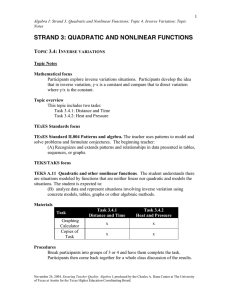STRAND 3: QUADRATIC FUNCTIONS T 3.1: U
advertisement
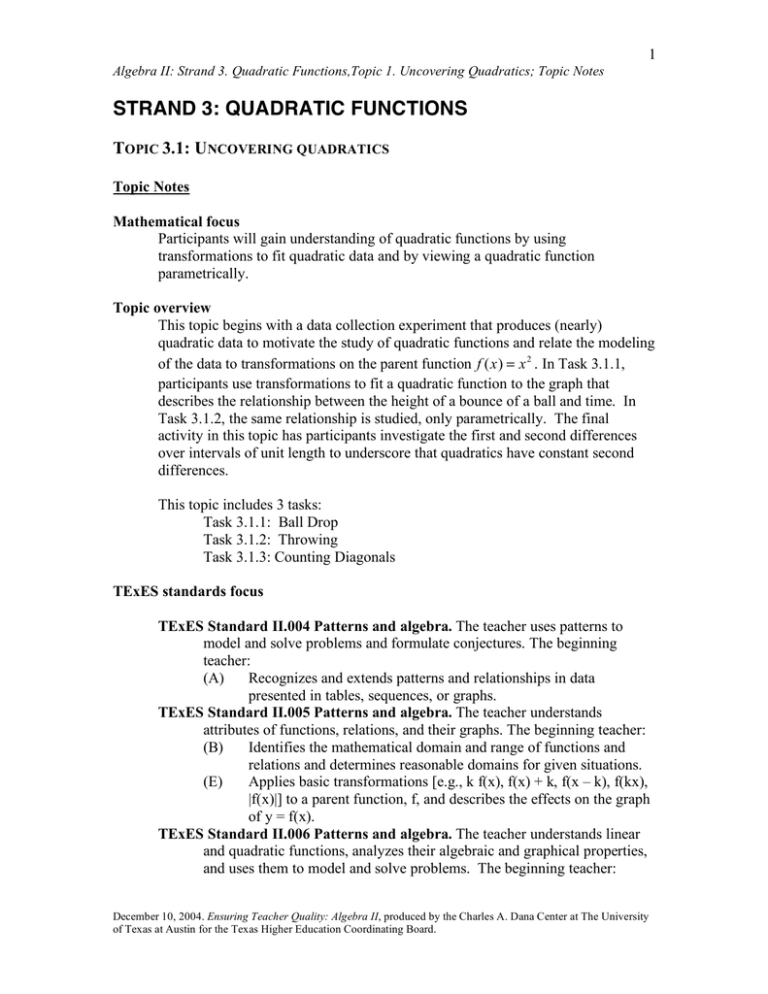
1 Algebra II: Strand 3. Quadratic Functions,Topic 1. Uncovering Quadratics; Topic Notes STRAND 3: QUADRATIC FUNCTIONS TOPIC 3.1: UNCOVERING QUADRATICS Topic Notes Mathematical focus Participants will gain understanding of quadratic functions by using transformations to fit quadratic data and by viewing a quadratic function parametrically. Topic overview This topic begins with a data collection experiment that produces (nearly) quadratic data to motivate the study of quadratic functions and relate the modeling of the data to transformations on the parent function f (x) = x 2 . In Task 3.1.1, participants use transformations to fit a quadratic function to the graph that describes the relationship between the height of a bounce of a ball and time. In Task 3.1.2, the same relationship is studied, only parametrically. The final activity in this topic has participants investigate the first and second differences over intervals of unit length to underscore that quadratics have constant second differences. This topic includes 3 tasks: Task 3.1.1: Ball Drop Task 3.1.2: Throwing Task 3.1.3: Counting Diagonals TExES standards focus TExES Standard II.004 Patterns and algebra. The teacher uses patterns to model and solve problems and formulate conjectures. The beginning teacher: (A) Recognizes and extends patterns and relationships in data presented in tables, sequences, or graphs. TExES Standard II.005 Patterns and algebra. The teacher understands attributes of functions, relations, and their graphs. The beginning teacher: (B) Identifies the mathematical domain and range of functions and relations and determines reasonable domains for given situations. (E) Applies basic transformations [e.g., k f(x), f(x) + k, f(x – k), f(kx), |f(x)|] to a parent function, f, and describes the effects on the graph of y = f(x). TExES Standard II.006 Patterns and algebra. The teacher understands linear and quadratic functions, analyzes their algebraic and graphical properties, and uses them to model and solve problems. The beginning teacher: December 10, 2004. Ensuring Teacher Quality: Algebra II, produced by the Charles A. Dana Center at The University of Texas at Austin for the Texas Higher Education Coordinating Board. 2 Algebra II: Strand 3. Quadratic Functions,Topic 1. Uncovering Quadratics; Topic Notes (C) Applies techniques of linear and matrix algebra to represent and solve problems involving linear systems. (F) Solves problems involving quadratic functions using a variety of methods (e.g., factoring, completing the square, using the quadratic formula, using a graphing calculator). (G) Models and solves problems involving linear and quadratic equations and inequalities using a variety of methods, including technology. TExES Standard V.018 Mathematical processes and perspectives. The teacher understands mathematical reasoning and problem solving. The beginning teacher: (E) Understands the problem-solving process (i.e., recognizing that a mathematical problem can be solved in a variety of ways, selecting an appropriate strategy, evaluating the reasonableness of a solution). TExES Standard V.019 Mathematical processes and perspectives. The teacher understands mathematical connections both within and outside of mathematics and how to communicate mathematical ideas and concepts. (B) Understands how mathematics is used to model and solve problems in other disciplines (e.g., art, music, science, social science, business). (D) Communicates mathematical ideas using a variety of representations (e.g., numeric, verbal, graphical, pictorial, symbolic, concrete). (E) Understands the use of visual media, such as graphs, tables, diagrams, and animations, to communicate mathematical information. TEKS/TAKS focus TEKS 2A.1 Foundations for functions. The student uses properties and attributes of functions and applies functions to problem situations. The student is expected to: (B) collect and organize data, make and interpret scatter plots, fit the graph of a function to the data, interpret the results, and proceeds to model, predict, and make decisions and critical judgments. TEKS 2A.3 Foundations for functions. The student formulates systems of equations and inequalities from problem situations, uses a variety of methods to solve them, and analyzes the solutions in terms of the situations. The student is expected to: (A) analyze situations and formulates systems of equations in two or more unknowns or inequalities in two unknowns to solve problems; and (B) use algebraic methods, graphs, tables, or matrices, to solve systems of equations or inequalities. TEKS 2A.4 Algebra and geometry. The student connects algebraic and geometric representations of function. The student is expected to: December 10, 2004. Ensuring Teacher Quality: Algebra II, produced by the Charles A. Dana Center at The University of Texas at Austin for the Texas Higher Education Coordinating Board. 3 Algebra II: Strand 3. Quadratic Functions,Topic 1. Uncovering Quadratics; Topic Notes (A) identify and sketch graphs of parent functions, including linear (f(x) = x), quadratic (f(x) = x2), exponential (f(x) = ax), and logarithmic (f(x) = logax) functions, absolute value of x (f(x) = |x|), square root of x (f(x) = √x), and reciprocal of x (f(x) = 1/x); TEKS 2A.6 Quadratic and square root functions. The student understands that quadratic functions can be represented in different ways and translates among their various representations. The student is expected to: (B) relate representations of quadratic functions, such as algebraic, tabular, graphical, and verbal descriptions. TEKS 2A.7 Quadratic and square root functions. The student interprets and describes the effects of changes in the parameters of quadratic functions in applied and mathematical situations. High School TAKS Objective 1: The student will describe functional relationships in a variety of ways. High School TAKS Objective 2: The student will demonstrate an understanding of the properties and attributes of functions. High School TAKS Objective 5: The student will demonstrate an understanding of quadratic and other nonlinear functions. Materials Task Ball (basketball, racquetball) Electronic data collection device Graphing calculator Task 3.1.1 Ball Drop X X X Task 3.1.2 Throwing Task 3.1.3 Counting Diagonals X X X Procedure These three tasks can be done in any order. If you are short on time, do only Task 3.1.3, as it introduces the essence of a quadratic function, constant second differences, which leads into the ideas studied in calculus, and it provides a nice connection to geometry. Summary The big idea here is that quadratic functions have linear first differences, i.e. constant second differences. Extensions Task 3.1.2 may be used as an extension as parametric equations are not part of the Algebra 2 TEKS. Teacher use only Task 3.1.1 Task 3.1.2 Task 3.1.3 Modify for students Ready for students * * * December 10, 2004. Ensuring Teacher Quality: Algebra II, produced by the Charles A. Dana Center at The University of Texas at Austin for the Texas Higher Education Coordinating Board. 4 Algebra II: Strand 3. Quadratic Functions,Topic 1. Uncovering Quadratics; Topic Notes December 10, 2004. Ensuring Teacher Quality: Algebra II, produced by the Charles A. Dana Center at The University of Texas at Austin for the Texas Higher Education Coordinating Board.
